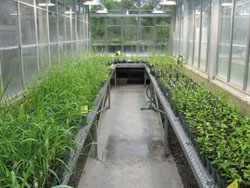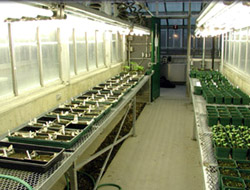Laboratories and research support: greenhouse and growth chambers
| Article Title |
|---|
Greenhouse and Growth Chambers |

Native plants are exposed to pesticides and other contaminants that may impact their survival, growth and reproduction, and thus have impact on other wildlife that may depend on them for food or habitat.
Advancing research on phytotoxicity testing is helping to bridge the gap between artificial laboratory testing with crops, and testing with native plants under conditions that emulate plant communities in their natural environments. These tests seek to reproduce natural conditions in order to yield more accurate results and better inform decision making about the control of chemical substances.
Current research and methodology
Located at the National Wildlife Research Centre, the Greenhouse and Growth Chambers have recently contributed to the understanding of:
-
Sublethal effects of herbicide use on native plants in terms of long-term recovery

- The comparative effects of herbicides on communities of plants grown in mesocosms in the greenhouse and in outdoor conditions
- The ability to measure sources of variability in phytotoxicity testing with herbicides
- Effects of conventional and organic farming practices, habitat types and landscape features on biodiversity, including native plants, moths, other arthropods and birds
- Evaluating the restoration potential of Middle Island (Lake Erie) ecosystems through a seed bank study and vegetation survey
- Effects of vanadium and lanthanum on native plant species
Research undertaken in the greenhouse and growth chambers integrates a variety of approaches and directions to fulfill several distinct objectives.
Some methods and equipment used include:
- Track spray booth equipped with a TeeJet 8002E flat-fan nozzle (Spraying Systems)
- Kinetic fluorescence CCD camera to measure chlorophyll fluorescence
- Portable photosynthesis system
- AP4 cycling diffusion porometer to measure stomatal conductance
- Spectrometer photodiode light sensor (μmol m-2 s-1) to measure light intensity
Collaboration

Phytotoxicity testing aimed at improving pesticide risk assessment is carried out in collaboration with the Pest Management Regulatory Agency funded under the Pesticide Science Funds.
Using inorganic compounds, researchers develop and improve the testing of native plants, as part of the Chemicals Management Plan using the medium priority substances list.
Experts in laboratory
- Céline Boutin
- Rebecca Dalton
- Pamela Martin
Further reading
- Organisation for Economic Co-Operation and Development. Terrestrial Plant Test: Seedling Emergence and Seedling Growth Test, no 208 and 227. OECD Guidelines for the Testing of Chemicals. Paris, France.
- Boutin, C. et al. Effects of cormorants on island vegetation, soil seedbank and soil chemistry: evaluating island restoration potential. Restoration Ecology (in press)
- Dalton, R. L. and C. Boutin. 2010. Evaluation of phytotoxicty testing: Comparing the effects of glyphosate and atrazine herbicides on non-target plants grown singly and in microcosms. Environ. Toxicol. Chem. 29(10): 2304-2315.
- White, A.L. et al. 2009. Germination requirements for 29 terrestrial and wetland wild plant species appropriate for phytotoxicity testing. Pest Management Science, 65: 19-26.
- Bowers, K. and C. Boutin. 2008. Evaluating the relationship between floristic quality and measures of plant diversity along stream bank habitats. Ecological Indicators 8:466-475.
- White, A.L. and C. Boutin. 2007. Herbicidal effects on non-target vegetation: investigating the limitations of current pesticide registration guidelines. Environ. Toxicol. Chem. 26(12):2634-2643.
- Chemicals Management Plan, Environment Canada
- Canadian Environmental Protection Act, 1999, Government of Canada
- Chemical Substances, Government of Canada